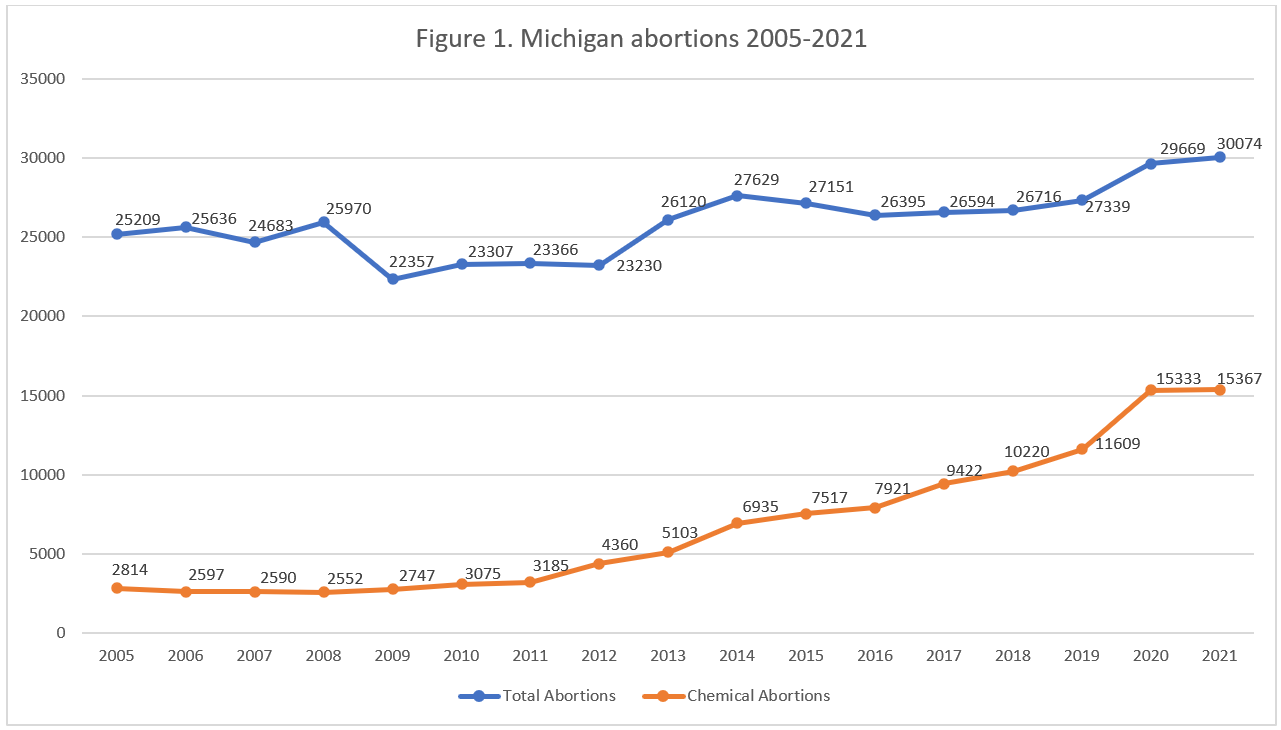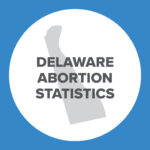Abortion Reporting: Michigan (2021)
The Michigan Department of Health and Human Services published Michigan’s 2021 abortion statistics in June 2022, showing that abortions are up in the Great Lakes State.
Statistics and Changes in Michigan Abortions, 2020-2021

The report does not include information on Planned Parenthood’s Michigan abortion market share.
Abortion Totals and Trends
In 2021, there were 30,074 abortions reported in Michigan, up nearly 1.3 percent from the previous year and the highest reported total since 1996. Chemical abortions increased ever so slightly, by .22 percent, making up 51 percent of the total in 2021 (Fig 1). The Charlotte Lozier Institute (CLI) estimates that Michigan’s 2021 abortion rate weas 15.9 abortions per 1,000 women ages 15 to 44, an increase from 2020 by one percent. As of October 2022, 23 states had released 2021 statistics, of which 16 showed that abortions had increased.
State Report Summary
Resident Abortions
In 2021, 94 percent of Michigan abortions were performed on residents, and much of the information in Michigan’s report is for residents only. Eight percent of the abortions performed on Michigan residents were on girls younger than 20, and 27 percent were on women ages 20 to 24. Thirty-one percent were on women ages 25 to 29, and 31 percent were on women ages 30 to 39. Three percent of the abortions were performed on women in their forties or older, and under one percent were on women whose age was not reported.
Over half of Michigan resident abortions were performed on black women (56 percent), while 35 percent were obtained by white women. Two percent were performed on Asian or Pacific Islander women, 0.5 percent on American Indian women, and another two percent each on multiracial women and women of other races. Race was not reported for four percent of the abortions. The black abortion rate (52.5 abortions per 1,000 women ages 15 to 44) was nearly eight times higher than the white abortion rate of 6.9. Michigan reports ethnicity separately from race, and three percent of resident abortions were performed on Hispanic women.
Twelve percent of resident abortions were on married women, 85 percent on unmarried women, and three percent on women of unknown marital status. A tick under a third (32 percent) of the abortions were performed on women with no previous term pregnancies. A tick over a quarter of the abortions, 26 percent, were on women with one prior term pregnancy, and 42 percent were on women with two or more. Just under half of the abortions (48 percent) were on women who reported no previous abortions; a quarter were on women with one prior abortion, and just over a quarter (26 percent) were on women with more than one. A quarter of the abortions were performed on women who previously had a miscarriage.
Michigan records the entity that referred each woman to the abortion facility, and in 2021 a majority of the abortions (86 percent) were self-referrals. Eleven percent of the women undergoing abortions were referred by friends or family members, and one percent were referred by a physician. Less than one percent of women were referred by a family planning agency, 10 women by clergy, five by a health department, and two by a social agency. There were 210 women (0.7 percent) who received some other referral. The source of referral was not reported for 101 abortions. The vast majority of the abortions on Michigan residents, 97 percent, were self-pay, while three percent were covered by insurance.
Total Abortions
Seventy percent of all abortions reported in Michigan occurred at eight weeks of gestation or earlier, with one percent performed before five weeks of gestation and 69 percent performed between five and eight weeks. Nineteen percent were performed between nine and 12 weeks. Seven percent of the abortions occurred from 13 to 16 weeks of gestation and three percent were performed between 17 and 20 weeks. There were 381 abortions, one percent of the total, performed at 21 weeks and later; of these, 374 abortions were performed between 21 and 24 weeks, five between 25 and 28 weeks, and two at 28 weeks of gestation or later. Gestational age was not reported for 0.3 percent (98) of the abortions.
A majority of the abortions reported in Michigan, 51 percent, were by chemical means. Forty-two percent were suction curettage procedures, and six percent were dilation and evacuation (dismemberment) abortions. There were four dilation and curettage abortions, one hysterotomy or hysterectomy procedure, and forty-two other, unspecified procedures. The type of procedure was not reported for 145 abortions (0.5 percent).
In 94 percent of cases, pregnancy was confirmed via ultrasound. For five percent, pregnancy was confirmed with a home urine test, and for 0.4 percent, pregnancy was determined with a lab urine test. There were nine pregnancies confirmed using a lab blood test, three in which another method was used, and 13 in which the method of confirming pregnancy was not reported. There were 10 abortions for which no method was used to confirm pregnancy.
Eighty-nine percent of Michigan abortions were performed in freestanding abortion facilities. One percent were performed in doctor’s offices, 0.8 percent in hospitals, and nine percent in some other type of facility. Five percent (1,405) of the unborn babies killed by abortion weighed one to 99 grams, and two percent weighed between 100 and 399 grams. There were 135 babies who weighed 400 grams or more (0.4 percent). However, weight was not determinable for 93 percent of the unborn babies.
Abortion Complications
There were four immediate complications reported during the abortion procedure, including two instances of hemorrhage and two infections.1 Additionally, 132 abortions resulted in complications subsequent to the abortion procedure. Multiple complications can be reported for each abortion. There were 87 failed abortions, which usually indicates that the abortion did not work, and the pregnancy is ongoing. There were 31 cases of retained products, nine instances of hemorrhage, three infections, and two other, unspecified complications. Uterine perforation and one cervical laceration occurred.
Of the 132 abortions resulting in post-abortion complications, 75 were suction curettage procedures and 40 were chemical. Twelve of the abortions causing complications were dilation and evacuation abortions, and four were performed using other, unspecified methods. Unlike other states, chemical abortions had a lower complication rate than surgical abortions; this may have been a result of a higher complication rate from late-term abortions or some chemical abortion complications going unreported.
Legislative Changes
Michigan had a 1931, pre-Roe law on the statute books that would prohibit abortion except in the cases where a mother’s life is in danger, but the law is not in effect following the overturning of the Roe v. Wade (1973) decision in June 2022. The law was blocked from enforcement in September 2022 by the Michigan Court of Claims.
State Ranking
In 2016, CLI published a paper surveying abortion reporting across the country, and Michigan’s reports tied for seventh best. As CLI has previously recommended, Michigan could make its reporting even better by providing detailed information for all abortions occurring in the state, not just those performed on residents. Additionally, Michigan could identify the states from which nonresident women travel for abortions. With the increase in chemical abortion nationally, more thorough efforts to identify complications of chemical abortion and treatment for same by emergency rooms and other providers are strongly advisable.


- Statistics on abortion complications reported here represent a minimal number of deaths and complications, as this data is collected in a non-systematic and non-verifiable way. As such, this data cannot be used to calculate either an accurate abortion mortality rate or an accurate abortion complication rate for the state.
- Rates were calculated by CLI using the following formula: (total number of abortions performed in Michigan ÷ number of resident women ages 15-44) x 1,000. Rates may differ slightly from previous CLI articles due to revised population estimates. Population estimates were obtained from the CDC WONDER database. Estimates for 2005-2009 are intercensal estimates of the July 1 resident population. Estimates for 2010-2019 are Vintage 2020 postcensal estimates of the July 1 resident population. Estimates for 2020-2021 are Vintage 2021 postcensal estimates of the July 1 resident population. Estimates were produced by the U.S. Census Bureau and the National Center for Health Statistics.



























